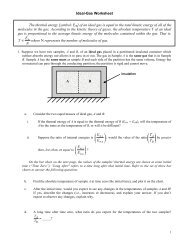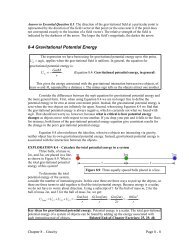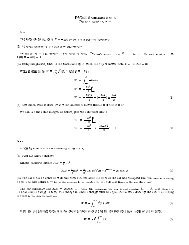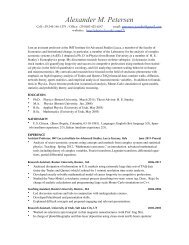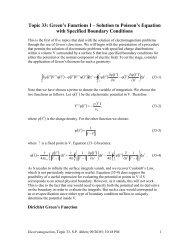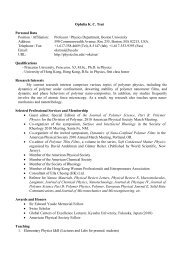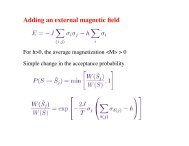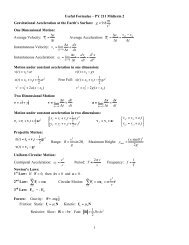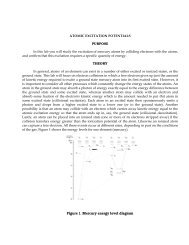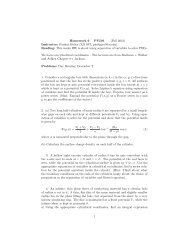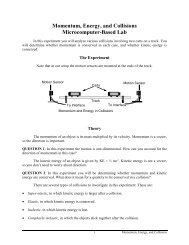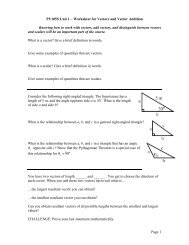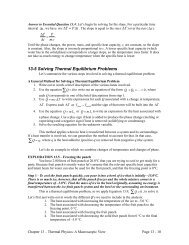Crystal Structure 1 3.1 Some Basic Concepts of Crystal Structure ...
Crystal Structure 1 3.1 Some Basic Concepts of Crystal Structure ...
Crystal Structure 1 3.1 Some Basic Concepts of Crystal Structure ...
Create successful ePaper yourself
Turn your PDF publications into a flip-book with our unique Google optimized e-Paper software.
<strong>Crystal</strong> <strong>Structure</strong><br />
According to eqn.10, the Bragg law is equivalent to:<br />
2k<br />
sin<br />
G<br />
<br />
G<br />
2k<br />
G<br />
G<br />
<br />
2<br />
2k<br />
G<br />
G<br />
<br />
k ( G)<br />
(<br />
1<br />
2<br />
1<br />
2<br />
<br />
G)<br />
2<br />
which is the same as eqn. 3.23. This proves our proposition. Since this conclusion is<br />
general to all kinds <strong>of</strong> waves, it is valid in particular to electron waves traversing in the<br />
crystal. This result says that electrons with wavevector k reaching a Brillouin zone<br />
boundary will suffer strong Bragg diffraction by the crystal planes.<br />
3.32 <strong>Structure</strong> Factor and Form Factor<br />
Let’s now come back to the evaluation <strong>of</strong> the scattering amplitude F from eqn.<br />
3.22. Substitute eqn. <strong>3.1</strong>5 in eqn. 3.22:<br />
F = V n G (Gk)<br />
= dV n(r) exp[ik r]<br />
If N is the total number <strong>of</strong> unit cells in the solid, and because the crystal is periodic,<br />
F = N unit cell dV n(r) exp[ik r] (3.24)<br />
= N S G<br />
where S G is called the structure factor. Note that it is an integral over a unit cell, with r =<br />
0 at one corner. It is <strong>of</strong>ten convenient to write the electron concentration as the<br />
superposition <strong>of</strong> electron concentration functions, n j associated with each atom j in the<br />
basis. If r j is the position vector <strong>of</strong> the atom j in the basis, our proposition means that<br />
s <br />
n(<br />
r ) <br />
n ( r r ) , (3.25)<br />
where s is the total number <strong>of</strong> atoms in a cell. Note that the expansion <strong>of</strong> n(r) in the form<br />
<strong>of</strong> eqn. 3.25 is not unique. Particularly, it is not possible to distinguish how much charge<br />
is associated with each atom. But this in general is not a problem.<br />
S<br />
G<br />
<br />
<br />
s<br />
j1<br />
s<br />
<br />
j1<br />
j 1<br />
j<br />
j<br />
<br />
dVn<br />
j<br />
( r rj<br />
)exp( ik<br />
r )<br />
<br />
exp( ik<br />
r ) dVn (<br />
)exp( ik<br />
<br />
) , (3.26)<br />
where is defined as r r j . We now defined the atomic form factor as:<br />
j<br />
<br />
j<br />
23



![arXiv:1303.7274v2 [physics.soc-ph] 27 Aug 2013 - Boston University ...](https://img.yumpu.com/51679664/1/190x245/arxiv13037274v2-physicssoc-ph-27-aug-2013-boston-university-.jpg?quality=85)
